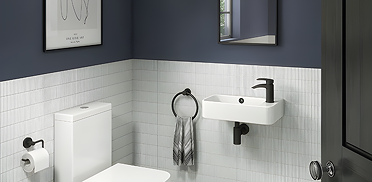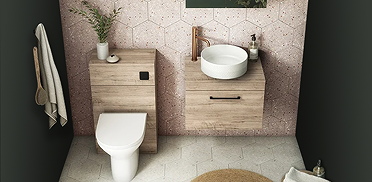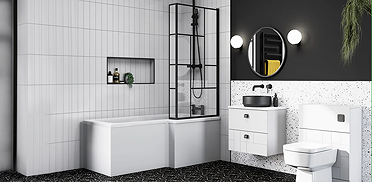UP TO 60% OFF BIG BATHROOM SALE ENDS SOON!
*Free delivery on orders over £499
Where to Place a Radiator
Where to Place a Radiator
Your toes are numb, the thermostat’s sulking, and the heat you’re paying for is, quite literally, going down the drain. Fix the placement. Fix the chill. Simple.
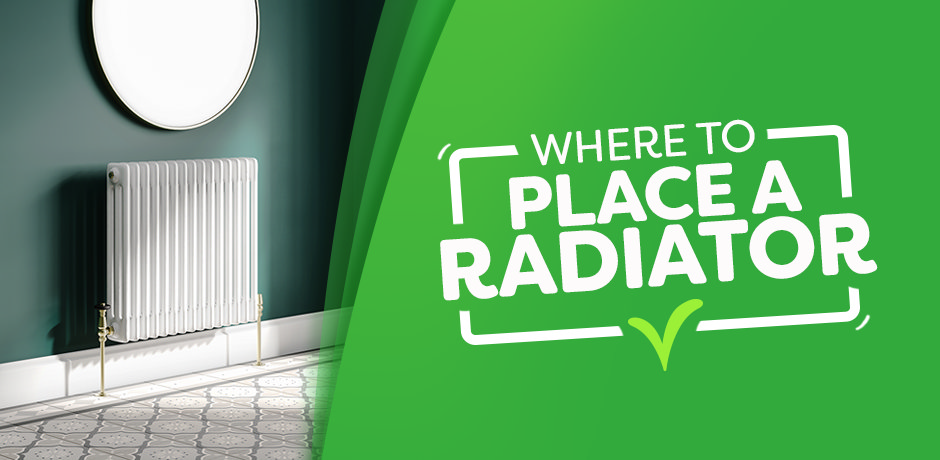
A well placed radiator delivers more heat, costs less to run and frees up wall space for furniture or décor. Use the radiator positioning advice below to find the best place for a radiator in living rooms, bedrooms, kitchens, bathrooms, hallways and utility areas.
Contents
(tap a heading to jump)
- Living-room tactics
- Bedroom sweet-spots
- Kitchen conundrums
- Bathroom & towel-rail logic
- Hallway & landing draught defence
- Utility, cloakroom & “spare” spaces
- Radiator types & where they shine
- Older homes vs. Modern homes
- FAQs & final thoughts
Where to place a radiator in your living room
Living areas typically benefit from even, all-around warmth — and they often double as interior design showcases, so smart radiator placement matters for both feel and look. Here’s the best places for a radiator in your living room.
Under the window

This classic spot isn’t just about habit. In older homes with single glazing, sticking a radiator under a window creates a warm air curtain that fights cold downdrafts from the glass. You’ll also free up more practical wall space — no one’s putting a bookshelf under the sill.
Pro tip: Add a shelf or foil behind to push heat forward and stop it leaching through the glass.
Modern setup?
If you’ve got a double-glazed bay or super-insulated exterior wall, feel free to break tradition. Positioning a radiator on an interior wall often keeps the heat in the room longer — no drafts to battle, and less heat loss overall.
Mind the Furniture
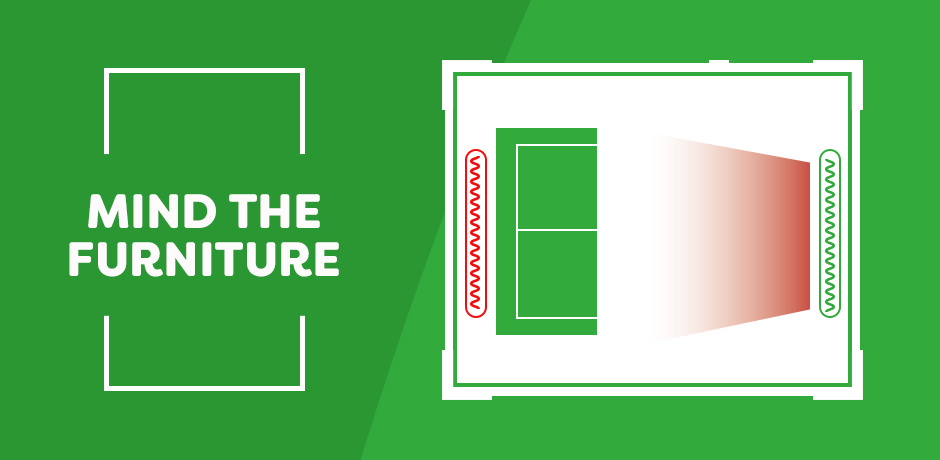
Curtain call
Floor-length curtains hanging over a rad can block and vent 4–15% of the heat. Hem them to stop above the grille, or hook/tuck them when the radiator’s in use. You’ll feel the difference.
Open-plan living room? Bay window nook? Anything over 20 m²? One hulking radiator often leaves you with a "sunspot vs. iceberg" vibe.
Smarter move: Go for two smaller radiators spaced out (e.g. flanking a bay window or placed on opposite long walls). It evens out the warmth and looks balanced too.
- Fit thermostatic radiator valves (TRVs) to each one for smart zone control.
- For multi-use spaces (reading corner, dining zone, etc.), think about zoned warmth — different rads for different vibes.
Bonus tips
- Radiator near an external door? Great for warming incoming draughts.
- TRVs on every unit = better zone control and energy savings.
- Solid walls for heavy radiators; anchors for lighter panels.
- Open-plan living? Place rads near glass doors or cold-prone zones for even coverage.
Where to place a radiator in your bedroom
Getting cosy without overheating — that’s the bedroom radiator sweet spot. Whether you’re designing from scratch or rearranging a box room, here’s how to stay warm, sleep well, and avoid waking up in a sweaty fog.
Not Beside the Pillow
Radiator right next to your head? Bad idea. You’ll wake up feeling parched, sticky, and mildly confused. And if you tend to toss and turn, sleeping too close to a hot panel can lead to uncomfortable skin contact Always aim to keep the radiator away from direct contact with the bed — whether at your head, feet, or sides.
Best practice: Position it on the opposite wall or under the window. This keeps the bed area cooler but the room evenly warm.
Under the Window = Still Solid
This classic spot works well — especially if the wall space is free and you’re not using floor-length curtains. The radiator counters any cold seeping through the glass, and there’s usually nothing blocking the area.
But: if you do have heavy curtains or blackout blinds, hem them to stop above the radiator or tuck them behind it when in use. Otherwise, they’ll trap warmth between fabric and glass — heating your window, not your room.
Interior Wall? Go for It
If your room is modern and well-insulated (think double glazing and decent loft insulation), mounting your radiator on an interior wall can help keep the heat inside. You’ll lose less warmth to the outdoors — just know that it might not ‘wash’ the window area with warm air, so avoid placing your bed right up against chilly glazing.
Avoid Blocking It
Radiators don’t like being smothered. If you’ve wedged a tall dresser, chunky bed frame, or pile of clutter in front of it — you’re not just blocking heat, you’re inviting warped furniture and cold toes.
Plan ahead: Leave clearance for airflow. A radiator behind a door that’s always open? Also a waste — the door will block the heat from reaching the room.
For kids' bedrooms, steer clear of putting rads behind the bed or in toy-clutter zones.
Small Box Room? Go Vertical
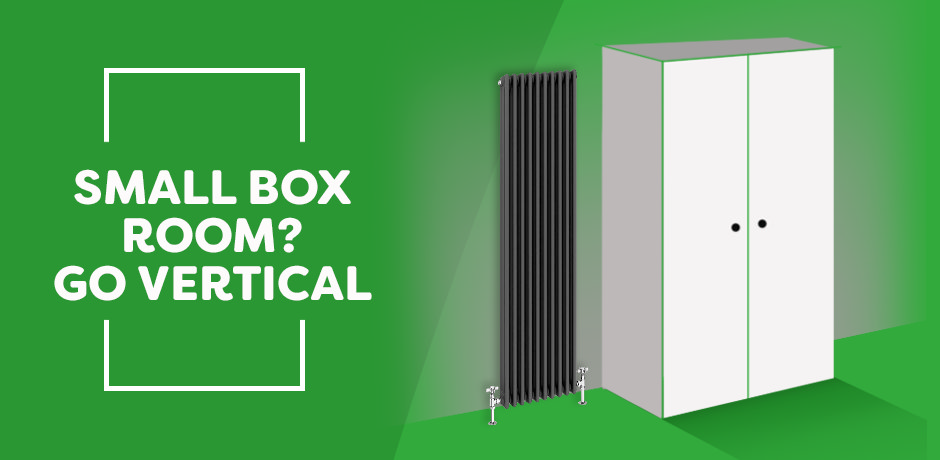
Got more wardrobes than wall space? A 400 × 1800 mm vertical flat panel could be your new best friend. It frees up floor area, pumps out decent heat, and squeezes in neatly beside doors or wardrobes. Just don’t install it too close to the bed — remember the “Sahara head” rule.
Thermostatic Control = Sleep Smarter
Bedrooms don’t need to be roasting. That’s why TRVs (thermostatic radiator valves) are your best mate. Set it lower than the living room, or use a programmable or smart TRV to warm up in the morning and drop overnight.
Too warm with the door closed? Turn the TRV down slightly — or open the door to let heat from the hallway flow in.
Where to place a radiator in your kitchen
Kitchen radiators can be a design puzzle: limited walls, surprise heat from cooking, and nowhere to squeeze a standard unit between the fridge and the five-slice toaster. But with a bit of planning (and a dash of cunning), you can keep things cosy without compromising storage, efficiency, or aesthetics.
Keep It Away from Appliances
Fridges and radiators make for an expensive tug-of-war. Radiators next to cold storage force your fridge or freezer to work overtime, burning through energy and shortening lifespan. Similarly, ovens and hobs are already hot zones — no need to double up.
Golden rule: Put your radiator on the opposite wall from your appliances, or at least away from major heat sources. If one wall has cabinets and cookers, look to the other for a slimline panel or vertical rad that stays out of the way but brings the warmth.
Use Vertical Space
In kitchens, the walls are spoken for — cupboards, shelves, splashbacks. Enter the vertical radiator. Even a 1800 × 300 mm panel can slot neatly into a 45 cm gap, like between a door and cabinet run or tucked near the entrance.
These tall rads use height instead of width, so they won’t steal cabinet space or crowd your prep zone. Just make sure there’s enough clearance for drawers and doors to open without bumping the rad.
Under the Window Works Too
Got a bit of free wall beneath the kitchen window? That’s prime radiator real estate. It’s a traditional spot for a reason: it counters window chill and often avoids interfering with units.
Just watch what’s nearby:
- Short curtains or blinds only — long ones are a fire risk and block heat.
- If the window’s by your breakfast nook, don’t shove chairs or benches up against the radiator — no one likes a toasted spine over toast.
No Wall Space? Go Low
No free wall at all? Time for a secret weapon: the kick-space heater (also called a plinth heater). These clever units sit beneath your base cabinets and blow out warm air — hydronic or electric. They warm your toes, save your walls, and leave splashbacks for, well, splashes.
Smart Controls & Cook-Time Cut-Offs
Cooking already heats the room — no need to go full sauna. That’s why a TRV (thermostatic radiator valve) is a must in the kitchen. Better still? Smart TRVs or dual-fuel towel rails you can control independently. That way, when your oven’s cranking out roast dinners at 200 °C, your radiator can chill out.
Pro tip: Smart home setup? Trigger a lower target temperature when the oven hits 40 °C+ — automation that keeps you cool under culinary pressure.
Warm the Draft, Not the Dog
If your kitchen has a back door or patio door, place a radiator near it to tackle cold air as it sneaks in. Just make sure:
- The door won’t bang into the radiator
- The rad doesn’t block walkways — no one wants third-degree burns while juggling a casserole dish.
Low-profile or recessed models are ideal for tight galley kitchens with narrow aisles.
Consider Specialty Radiators
Got a utility corner or laundry zone? A compact towel rail (yes, in the kitchen!) can dry dishcloths and warm the space. A small ladder-style radiator near the sink or back door can be both practical and space-smart — especially in open-plan homes with busy kitchen-diner zones.
Flat panel models can blend seamlessly into contemporary spaces. Or if your kitchen-diner leans more stylish, treat that side like a mini-living room and use a decorative vertical radiator as a feature piece.
Where to place a radiator in your bathroom & ensuite
Bathrooms are where you want spa-like warmth, not a steamy overheat or damp towel. Between the tiles, taps, and lack of wall space, getting the radiator right matters — both for comfort and for safety.
Grab-Zone Positioning
Towel rail within arm’s reach of the bath or shower give you that royal exit. Whether you’re stepping out of a rainfall shower or clambering from a quick rinse, the goal is simple: grab a pre-warmed, 22 °C towel without traipsing across cold tiles.
Ideal spots:
- Adjacent to the shower door
- Above the end of the bath
- Next to the bath or shower enclosure
Basically, anywhere that lets you towel off before the chills set in. In small spaces - near the door works too — giving you warm towels on entry and exit.
Dual-Fuel = Year-Round Glow
It’s July. The central heating’s off. Your towels still deserve warmth. Dual-fuel towel rails (central heating + electric element) mean you can flick on the radiator solo — perfect for drying towels or warming the room on cooler summer mornings. Just make sure the electrical spur is safely located (often outside the bathroom or fused in a safe zone).
IP Ratings & Bathroom Zones
Water we waiting for? Safety first. Radiators and electrics don’t always mix — so follow IP rating rules:
- Stay out of Electrical Zone 1 unless your radiator is IP65-rated or better.
- No electrics inside the shower or right above the tub unless they’re specifically designed for it.
Mount your towel rad where it’s safe and functional — especially with electric-only models. For hydronic rails, pipework often dictates position, but during a refit, have pipes moved to the ideal wall.
Spacing & Sizing Rules
Airflow is everything:
- Leave 100 mm clearance above and below your towel radiator.
- Rungs should be around 50 mm apart to help circulate warm air properly.
Avoid cramming it with towels — some empty space will give you better room heat. If your bathroom gets chilly when towels are hanging, consider upsizing your radiator or leaving it partially uncovered when heating is needed.
Also, mount at a practical height: reachable without stooping or stretching, with room above and below for hands, air, and heat.
Standard Rads Still Work (Sometimes)
Larger bathroom? Ensuite with lots of space? You might pair your towel rail with a standard panel radiator, especially if the towel rail doesn’t output enough BTUs solo.
Smart spot would be under the window or on a free wall opposite the tub — just not behind the loo or in anyone’s way. Avoid inward-opening shower doors smacking into it, and don’t block access to the bath or toilet.
Door Clearance & Compact Smarts
Towel rail next to a shower door or cubicle screen? A+ move. You’ll step out, swing open the glass, and boom — warm towel waiting. Just double-check your measurements so the door clears the radiator.
Small bathroom solutions:
- Behind the door (as long as you can still access it easily)
- Above a bidet or toilet (as long as no heads or shoulders will suffer)
- Use open-ended rungs or curved rails for better towel access
Where to place a radiator in hallways & landings
Hallways and landings might not be the comfiest hangout spots, but they’re the first place you feel when stepping inside — and the launch pad for warmth flowing through your home. A badly placed radiator here doesn’t just mean chilly welcomes — it can affect the whole house’s heat balance.
Let’s get it right.
Vertical by the Door
Cold gusts through the front door? Meet your match. Mounting a 300 mm-wide vertical radiator right beside (or just opposite) the entrance floods that high-traffic zone with warmth before the chill races upstairs. Bonus: it saves precious floor width and doubles as a sleek design piece in homes with tall ceilings or tight foyers.
Just make sure it’s:
- Not in the door swing path
- Properly anchored (kids, coats, and elbows may collide)
Central Location = Even Warmth
Don’t banish your hall radiator to a shadowy corner.
In long, narrow halls, mid-length placement on a long wall gives even heat spread. In wide foyers, a rad opposite or facing the door fills the space with warmth — ideally on an interior wall to avoid excess heat loss.
Pro tip: In multi-floor homes, consider radiators on both the hallway and upstairs landing. Heat rises, but not always enough to warm upper levels on its own.
Near the Door? Yes, but…
Traditionally, a radiator by the front door makes sense — it warms draughts as they enter. But don’t blast heat right into the cold — it could vanish through gaps and single glazing.
Better idea: Place the radiator a few feet inside, still near enough to warm the entrance but not directly next to leaky zones. A unit on the interior wall opposite the door is a sweet spot: incoming chill meets a wall of warmth.
Under-Stairs Trick
Got open stairs or a bit of dead space? Slide a low horizontal radiator underneath.
This:
- Reclaims unused square footage
- Keeps heat circulating gently upward
- Avoids bumped elbows in narrow walkways
Just make sure the space isn’t enclosed (cupboard = no airflow), and don’t oversize it. Heat trapped in a tight nook is wasted heat.
Keep the Path Clear
Hallways = walkways. Don’t turn them into obstacle courses.
- Use slimline radiators (10–15 cm thick)
- Avoid bulky old convectors
- If using a radiator cover, go vented and oversized — or better yet, pick a good-looking rad and skip the box altogether
And don’t hang coats or pile shoes in front of it. That “coat-drying corner” might feel smart but it blocks airflow and leaves the rest of the hallway cold.
Sizing for Stairs & Space
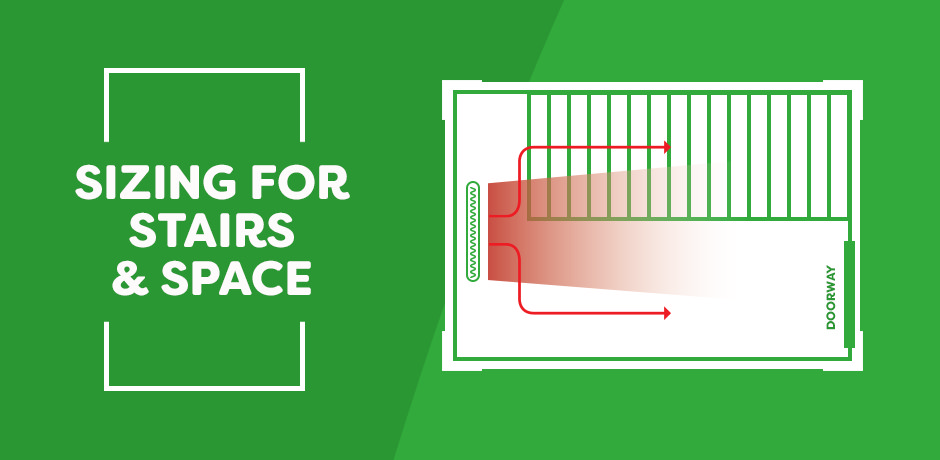
Hallways and landings can be deceptively hard to heat. Multiple doors = heat escape. Staircase = heat vacuum. So size up.
- Use a BTU calculator that includes ceiling height and landing volume
- Consider a double-panel radiator or high-output vertical column
- Always fit a TRV — it’s better to turn it down than underheat the entire hallway
Where to place a radiator in your utility, cloakroom & “spare” spaces
Utility rooms, cloakrooms, laundry corners, garage conversions — they’re not glamorous, but they are hardworking. These often-overlooked spaces still need heat: for comfort, for drying, and to keep pipes from staging a midwinter mutiny.
Drying Duty: The Towel Rail to the Rescue
Tall towel radiators are laundry lifesavers. Not just for towels — they warm the space and dry damp clothes. Install one near your washer/dryer setup or in the centre of the room so it can pull double duty.
- Leave 50 mm between rungs to let warm air circulate
- Ideal near a window (if you have one) to cut condensation
- Even better near a vent or dehumidifier to help moisture exit, not linger
You can even get models with built-in drying bars or hanging arms to air tea towels, gym kit, or soggy school uniforms.
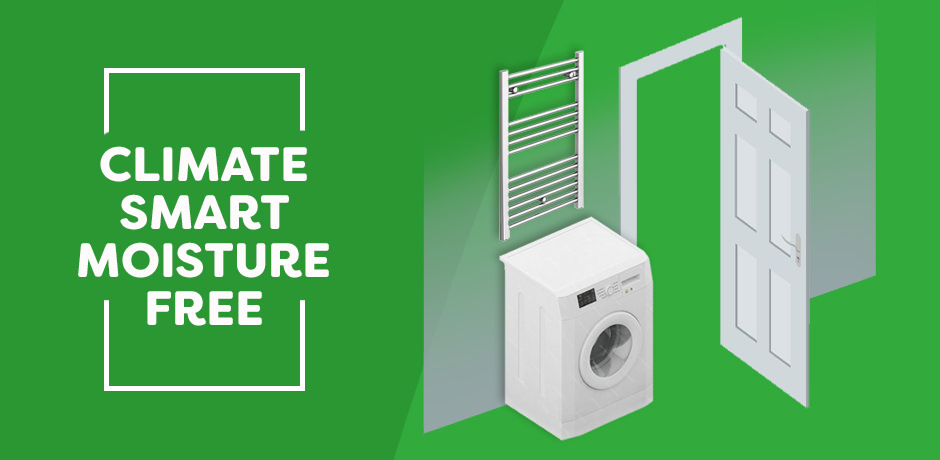
Think High (When You’re Low on Space)
No floor space? Mount a panel radiator higher up the wall — just above baskets, bins, or cleaning gear.
Above the washing machine is a smart shout: heat rises, laundry drips, and you’ve kept the floor tidy.
Just remember: high-mounted rads aren’t as effective at warming toes. So only go sky-high if ground-level space is truly off-limits. Otherwise, a tall, narrow towel rail on the back of the door or next to a shelf unit is often better.
TRV Frost-Set: Your Pipe Insurance Policy
Unheated garage conversion? Frost-prone outhouse?
A TRV set to its lowest "frost protection" mode keeps your radiator ticking over just enough to prevent frozen pipes. Ideal for:
- Utility rooms in extensions
- Boot rooms with outside access
- Conservatory-turned-laundry setups
Electric convectors also work well here — just wall-mount them where they won’t clash with wet hands or water lines.
Avoid Storage Clashes
Utility rooms are crowded at the best of times. Don’t block radiator airflow with:
- Plastic storage tubs
- Cleaning products
- Shelving units
Pick unused wall slivers, like under a window or beside the door. And never mount behind your dryer — heat and airflow matter more than hiding it.
Cloakroom Considerations
Cloakrooms and downstairs loos may be tiny, but they still need warmth.
- Slimline panel or towel rail under a window or opposite the toilet = best bet
- Avoid anything that gets in the way of knees or coats
- If the room opens into a hallway, that rad also helps buffer drafts between zones
Even a compact electric towel rail works wonders in WC setups — drying damp hand towels and fighting off morning chill.
Climate Smart = Condensation-Free
Utility rooms are moisture magnets — and smart radiator placement helps fight back.
Tips:
- Warm the cold spots: exterior walls, window zones
- Place the radiator where it can warm circulating air — not just a hidden nook
- Use in tandem with an extractor fan for full moisture management
- Avoid tucking the radiator behind large machines or deep storage
With room-by-room strategies covered, we can now look at how different radiator types influence placement and what modern upgrades can improve heating efficiency.
Radiator types and their best positions
Not all radiators are created equal – the type (design and heating method) of a radiator can determine where it fits best and how you should position it. Below is a comparison of common radiator types, their features, and typical room uses and placements:
| Radiator Type | Description & Features | Best Used In | Optimal Placement & Notes |
|---|---|---|---|
| Horizontal Panel Radiator (Single or Double Panel, often with convector fins) |
Standard rectangular radiator found in most homes. Double panels (Type 22) output more heat than single panels. Convector fins increase efficiency but need airflow below and above. | Living rooms, bedrooms, hallways – especially beneath windows. | Under windows or long walls with airflow clearance above and below. Avoid curtain or furniture blockages. Short blinds or café curtains recommended. |
| Vertical Radiator (Vertical panel or column) |
Tall, narrow unit for height-saving. Modern or traditional column styles available. Pushes heat upward – ideal for tall ceilings and tight wall widths. | Kitchens (between units), hallways, bathrooms, stairwells. | Narrow alcoves, between windows or doors. Must be securely fixed. Circulates heat upward. Ideal for walls without space for a panel rad. Pairs well either side of a mirror or window. |
| Column Radiator (Cast Iron or Multi-Column) |
Multiple vertical columns. Radiates evenly and stays warm longer. Often heavier. Adds vintage charm or traditional appeal. | Period properties, lounges, dining rooms, or spaces with original features. | Wall or floor mounted on solid walls. May need feet supports. Warms objects not just air. Avoid placing furniture directly in front. Slower to heat but longer lasting. |
| Towel Rail Radiator (Ladder Style) |
Towel-warming ladder-style radiator. Available as plumbed, electric or dual fuel. Compact and stylish. | Bathrooms, ensuites, cloakrooms, utility rooms, kitchens (for dish towels). | Mount near shower or bath for easy access. Towels can block heat. Oversize if main heater. Choose IP-rated if in wet zone and electric. |
| Electric Radiator / Panel Heater | Plug-in or hardwired heater. No plumbing needed. Comes with thermostats. Great for standalone or top-up heating. | Garden offices, extensions, conservatories, loft rooms. | Any safe wall near a power source. Avoid bathrooms unless IP-rated. Don’t place behind curtains or furniture. Use smart timers to save energy. |
| Dual Fuel Radiators (Central Heating + Electric) |
Radiators that can run on both central heating and electricity. Ideal for year-round towel drying without heating the whole house. | Bathrooms, utility rooms, or anywhere seasonal heating is handy. | Mount like a normal radiator, ensuring an accessible electric spur. Perfect hybrid for transitional weather. Allows electric use even when heating is off. |
As you can see, the type of radiator often complements the room: e.g., tall vertical rads in entryways or small kitchens, versus wide low radiators under bay windows in lounges. Always match the radiator size/type to the room’s heating requirement (use BTU calculators) and to the wall space available. A small bathroom might only fit a narrow towel rail, while a large open-plan area might need multiple panels or a combination of underfloor heating and radiators.
Remember also the distinction between radiant heat and convective heat: Radiators (despite the name) usually work by convection – warming air that then circulates. Placement under windows works well for convective currents (cold air in, warm air out. Some modern designs (like infrared panels) purely radiate heat to objects; those you’d place where they “shine” on people (like how you’d position a space heater), which is a different strategy. But for typical hydronic radiators, thinking about air flow (in from below, out from top) and cold spots is the way to go.
Radiator Placement: Older Homes vs. Modern Homes
Traditional UK heating lore says radiators belong under windows or on outside walls, placed for combating cold drafts. Modern heating design suggests radiators can go wherever convenient since homes can be made thermally efficient. Let’s weigh the pros and cons of the old-school approach versus new trends, keeping in mind the characteristics of older solid-wall homes versus newer insulated ones:
Explore More
Want to dive deeper? We’ve got you covered:
- Bathroom Buying Guides – Discover the best radiators for cloakrooms, ensuites, and statement bathrooms
- DIY Tips & Tricks – Learn how to fit a TRV, foil-line a wall, or mount a vertical radiator like a pro
- Design Inspiration – See how real customers are styling radiators into every room of the house
Need help choosing the right size or style? Our Radiator Range has models for every wall, nook, and draughty corner.
Boss your home’s warmth. One radiator, placed right, can make all the difference.

Jack
Jack is part of the resident bathroom bloggers team here at Victorian Plumbing. As a bathroom décor and DIY expert, he loves writing in depth articles and buying guides and is renowned for his expert 'how to' tutorials.
